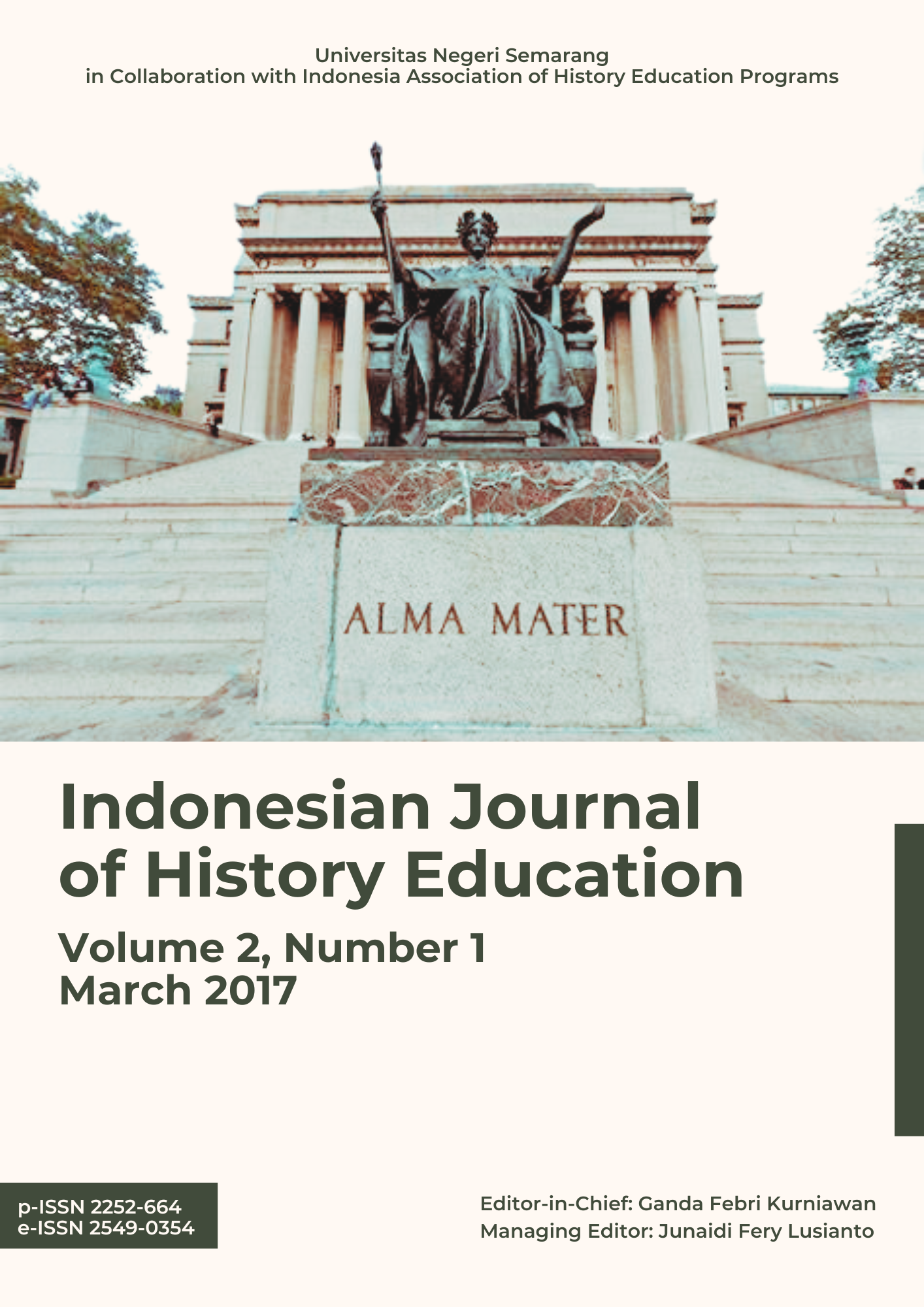Development of the E-Module on the History of the Entry of Islam in Pekalongan Regency Based on Project-Based Learning on Learning Interests of Class X IPS Students SMAN 1 Kedungwuni
Abstract
This study uses research and development models with descriptive quantitative analysis to describe the findings of research data. The objectives of this research are: (1) Know the stages of development of e-modules of historical learning; (2) Know the use of e-modules, and; (3) Increase the interest in learning grade X IPS 4 in SMAN 1 Kedungwuni through the use of e-module based on the local history of Islamic entry in Pekalongan Regency. The research used addie development models n-gain test analysis and linear regression. The results showed; (1) Based on the validity test of the e-module indicates that the e-module is qualified to be used as a learning resource; (2) Based on the n–gain test analysis of the pretest and posttest values obtained a figure of 0.79; (3) The development of e-modules affects the interest in learning the history of grade X IPS 4 students by 22.7% with a positive influence direction based on simple linear regression analysis.
References
Arsyad, A. (2011). Media Pembelajaran, cet. 14. Jakarta: PT. Raja Grafindo Persada.
Asyhar, R., Afrida, & Widiastiningsih. (2015). Pengembangan E-Modul Menggunakan Software 3D Pageflip Professional untuk Pembelajaran Ikatan Kimia Kelas X SMA Islam Al Falah Kota Jambi. Journal of The Indonesian Society of Integrated Chemistry, 7(1).
Bahri, S. (2011). Pengembangan Kurikulum Dasar dan Tujuannya. Jurnal Ilmiah Islam Futura, 11(1), 15–34.
Ganesan, M. (2015). Developing of E-content package by using ADDIE model. International Journal of Applied Research, 1(3), 52–54.
Gupta, S., & Shabbir, J. (2008). On improvement in estimating the population mean in simple random sampling. Journal of Applied Statistics, 35(5), 559–566. https://doi.org/10.1080/02664760701835839
Hamalik, O. (2008). Kurikulum dan Pembelajaran. Jakarta: Bumi Aksara.
Hapsari, N., Suyanto, S., & Budiwati. (2016). Pengembangan E-Modul Pengayaan Materi Pertumbuhan dan Perkembangan Untuk Meningkatkan Kemandirian dan Hasil Belajar. Jurnal Edukasi Biologi, 5(5).
Hasan, S. H. (2012). Pendidikan Sejarah Untuk Memperkuat Pendidikan Karakter. Paramita: Historical Studies Journal, 22(1). https://doi.org/10.15294/paramita.v22i1.1875
Hsu, T.-C., Lee-Hsieh, J., Turton, M. A., & Cheng, S.-F. (2014). Using the ADDIE Model to Develop Online Continuing Education Courses on Caring for Nurses in Taiwan. The Journal of Continuing Education in Nursing, 45(3), 124–131. https://doi.org/10.3928/00220124-20140219-04
Lickona, T. (2016). Educating for Character: Mendidikan untuk Membentuk Karakter (U. Wahyuni, Ed.). Jakarta: Bumi Aksara.
Machali, I. (2014). Kebijakan Perubahan Kurikulum 2013 dalam Menyongsong Indonesia Emas Tahun 2045. Jurnal Pendidikan Islam, 3(1), 71–94. https://doi.org/10.14421/jpi.2014.31.71-94
Meng, X. (2013). Scalable Simple Random Sampling and Stratified Sampling. Proceedings of the 30th International Conference on Machine Learning, 531–539.
Muhammedi. (2016). Perubahan Kurikulum di Indonesia : Studi Kritis Tentang Upaya Menemukan Kurikulum Pendidikan Islam yang Ideal. Jurnal Raudhah, 4(1), 49–70.
Nadiyah, R. S., & Faaizah, S. (2015). The Development of Online Project Based Collaborative Learning Using ADDIE Model. Procedia - Social and Behavioral Sciences, 195, 1803–1812. https://doi.org/10.1016/j.sbspro.2015.06.392
Nafisah, D. (2016). Peran Pendidikan Muatan Lokal Terhadap Pembangunan Karakter Bangsa. Citizenship Jurnal Pancasila Dan Kewarganegaraan, 4(2), 451. https://doi.org/10.25273/citizenship.v4i2.1078
Nasir, M. (2013). Pengembangan Kurikulum Muatan Lokal dalam Konteks Pendidikan Islam di Madrasah. HUNAFA: Jurnal Studia Islamika, 10(1), 1. https://doi.org/10.24239/jsi.v10i1.12.1-18
Ngamanken, S. (2014). Pentingnya Pendidikan Karakter. Humaniora, 5(1), 72. https://doi.org/10.21512/humaniora.v5i1.2983
Peterson, C. (2003). Bringing ADDIE to Life: Instructional Design at Its Best. Journal of Educational Multimedia and Hypermedia, 12(3), 227–241.
Qasim, M., & Maskiah, M. (2016). Perencanaan Pengajaran dalam Kegiatan Pembelajaran. Jurnal Diskursus Islam, 4(3), 484–492.
Samani, M., & Hariyanto, M. S. (2011). Konsep dan Model Pendidikan Karakter. Bandung: Remaja Rosdakarya.
Sholikhah, A. (2016). Statistik Deskriptif dalam Penelitian Kualitatif. KOMUNIKA: Jurnal Dakwah Dan Komunikasi, 10(2), 342–362. https://doi.org/10.24090/komunika.v10i2.953
Stanek III, E. J., Motta Singer, J. da, & Lencina, V. B. (2004). A unified approach to estimation and prediction under simple random sampling. Journal of Statistical Planning and Inference, 121(2), 325–338. https://doi.org/10.1016/S0378-3758(03)00114-9
Sugiyono. (2014). Metodologi Penelitian Pendidikan (Pendekatan Kuantitatif, Kualitatif dan R&D). Bandung: Alfabeta.
Sugiyono. (2016). Metode Penelitian dan Pengembangan (Research and Development/R&D). In Bandung: Alfabeta.
Uno, H. B. (2016). Perencanaan Pembelajaran. Jakarta: Bumi Aksara.
Wahyuni, F. (2015). Perubahan Kurikulum dari Masa ke Masa (Telaah Atas Pentahapan Kurikulum Pendidikan Di Indonesia). Al-Adabiya: Jurnal Kebudayaan Dan Keagamaan, 10(2), 231–242.
Widoyoko, E. P. (2010). Evaluasi Program Pembelajaran. Yogyakarta: Pustaka Pelajar.
Winaya, I. K. A., Darmawiguna, I. G. M., & Sindu, I. G. P. (2016). Pengembangan E-Modul Berbasis Project Based Learning pada Mata Pelajaran Pemrograman Web Kelas X di SMK Negeri 3 Singaraja. Jurnal Pendidikan Teknologi Dan Kejuruan, 13(2). https://doi.org/10.23887/jptk-undiksha.v13i2.8527.
Zahri Harun, C. (2015). MANAJEMEN PENDIDIKAN KARAKTER. Jurnal Pendidikan Karakter, 4(3). https://doi.org/10.21831/jpk.v0i3.2752.
Copyright (c) 2016 M Farid Hakim, YYFR. Sunarjan

This work is licensed under a Creative Commons Attribution 4.0 International License.
Copyright Notice
An author who publishes in the Jurnal Indonesian Journal of History Education agrees to the following terms:
- Author retains the copyright and grants the journal the right of first publication of the work simultaneously licensed under the Creative Commons Attribution-ShareAlike 4.0 License that allows others to share the work with an acknowledgement of the work's authorship and initial publication in this journal
- Author is able to enter into separate, additional contractual arrangements for the non-exclusive distribution of the journal's published version of the work (e.g., post it to an institutional repository or publish it in a book) with the acknowledgement of its initial publication in this journal.
- Author is permitted and encouraged to post his/her work online (e.g., in institutional repositories or on their website) prior to and during the submission process, as it can lead to productive exchanges, as well as earlier and greater citation of the published work (See The Effect of Open Access).
Read more about the Creative Commons Attribution-ShareAlike 4.0 Licence here: https://creativecommons.org/licenses/by-sa/4.0/.




